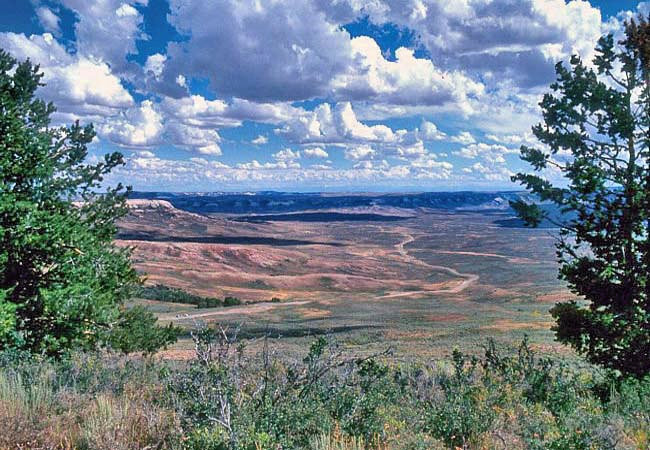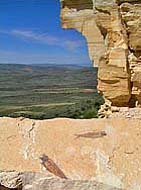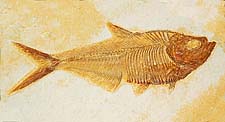|
Scenic USA - Wyoming Fossil Butte National Monument |

| Photo by Bob Fagley Fossil Butte Cliffs inset - courtesy NPS Diplomystus Fossil ~ J. A. Hudgins Collection |
Just east of the Idaho border, Fossil Butte National Monument  in Kemmerer is often referred to as America's Aquarium in Stone. Covering about 8000 acres, the high altitude park, ranging in elevation from 6500 to 8000 feet, remains frost free on average for only sixty days a year. This desert ecosystem, despite its extreme conditions, high altitude and frigid temperatures, is home to numerous pronghorn, porcupine, jackrabbits, eagles, coyotes and mule deer. Hiking the Historic Quarry Trail and the Chicken Creek Nature Trail are two of the best ways to experience the park's geology and wildlife.
in Kemmerer is often referred to as America's Aquarium in Stone. Covering about 8000 acres, the high altitude park, ranging in elevation from 6500 to 8000 feet, remains frost free on average for only sixty days a year. This desert ecosystem, despite its extreme conditions, high altitude and frigid temperatures, is home to numerous pronghorn, porcupine, jackrabbits, eagles, coyotes and mule deer. Hiking the Historic Quarry Trail and the Chicken Creek Nature Trail are two of the best ways to experience the park's geology and wildlife.
The name Fossil Butte does little to indicate something extraordinary is going on here at the national monument. As you may discover over the Quarry Trail, most of the park's wildlife was buried in Fossil Basin sediment during the Eocene Epoch more than 35 million years ago. Discovered by Union Pacific  Railroad workers in the late 1860s, the park's ancient lake bed contains hundreds-of-thousands fossilized animals and plants. Enclosed in fine-grained lake sediments, these rare and delicate fossils are among some of the best preserved specimens in the world. Lying sandwiched in multicolored layers (strata) of rock, the Green River Formation holds the skeletal remains of fish, birds, turtles, bats, dog-sized horses and insects. Even crocodiles are found buried in Fossil Butte's rock matrices.
Railroad workers in the late 1860s, the park's ancient lake bed contains hundreds-of-thousands fossilized animals and plants. Enclosed in fine-grained lake sediments, these rare and delicate fossils are among some of the best preserved specimens in the world. Lying sandwiched in multicolored layers (strata) of rock, the Green River Formation holds the skeletal remains of fish, birds, turtles, bats, dog-sized horses and insects. Even crocodiles are found buried in Fossil Butte's rock matrices.
Area Map

|
More Area Attractions |
|
Copyright © 2023 Benjamin Prepelka
All Rights Reserved
